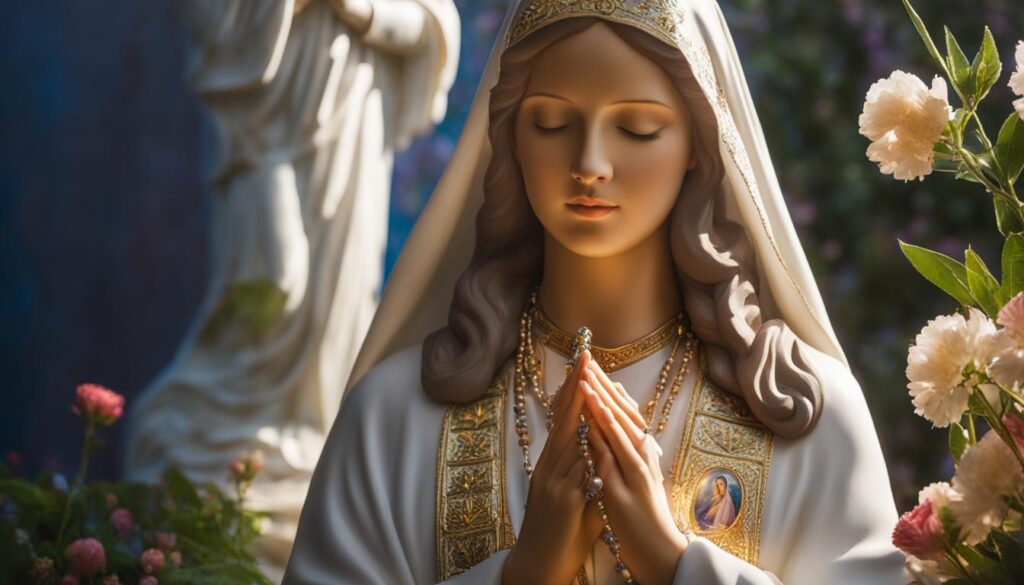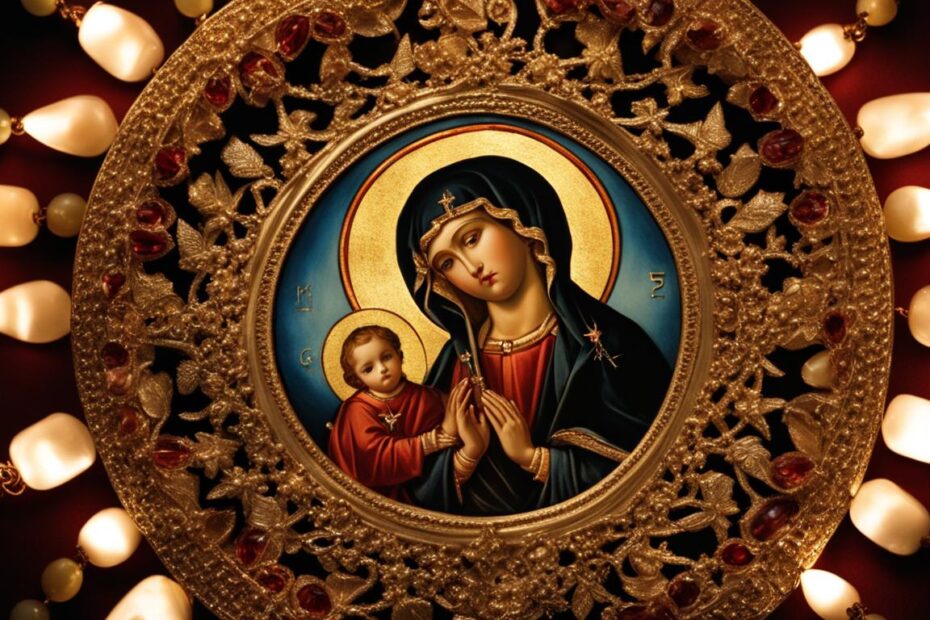Praying the Rosary is a sacred practice for Catholics to connect with God and seek His intercession. It involves the use of rosary beads and specific prayers. This guide will provide step-by-step instructions on how to pray the rosary correctly and offer helpful tips for a meaningful experience.
Key Takeaways:
- Praying the rosary is a way for Catholics to connect with God and seek His intercession.
- The rosary is more than just a tool for counting prayers; it is a means of entreaty and thanksgiving.
- By following the traditional method of saying the rosary, Catholics can experience the power of these prayers.
- Praying the rosary involves a specific sequence of prayers and meditations.
- Meditating on the mysteries of the rosary allows for deeper reflection and connection with God.
Understanding the Importance of the Rosary
The rosary is more than just a tool for counting prayers; it is a means of entreaty and thanksgiving. Catholics turn to the rosary to ask for God’s favor, seek His guidance, and express gratitude. It is a powerful way to deepen one’s prayer life and experience a greater sense of peace and spirituality.
The rosary prayers for beginners provide a structured and tangible form of communication with God. By incorporating the physical act of holding the rosary beads and reciting specific prayers, individuals can engage their senses and focus their minds on their spiritual connection. This rhythmic repetition creates a meditative state that allows for a deeper connection with God’s presence.
Deepening one’s prayer life with the rosary goes beyond the mechanical recitation of prayers. It involves embracing the symbolism and significance of each prayer and mystery. As Catholics meditate on the mysteries of Christ’s life and the role of Mary, they are invited to reflect on their own spiritual journey and seek a closer relationship with God. Through the rosary, individuals can find solace and strength, and experience the transformative power of prayer.
Benefits of Praying the Rosary:
- Enhances focus and concentration during prayer
- Deepens spiritual connection with God
- Brings a sense of peace and tranquility
- Provides a framework for meditating on the life of Christ
- Invokes the intercession of Mary and the saints
Quotes:
“The rosary is the ‘weapon’ for these times.” – Saint Padre Pio
“Give me an army saying the Rosary, and I will conquer the world.” – Blessed Pope Pius IX

The Traditional Method of Saying the Rosary
The traditional method of saying the rosary is a time-honored practice that has been passed down through generations of Catholics. It is a powerful way to connect with God, seek His intercession, and find solace and guidance in times of need. The method involves a sequence of prayers and meditations known as mysteries, which allow for contemplation of key events in the lives of Jesus and Mary.
The traditional method begins with making the sign of the cross, followed by the recitation of the Apostles’ Creed, the Our Father, three Hail Marys, and the Glory Be. These prayers serve as an introduction to the rosary and prepare the mind and heart for deeper meditation. Each decade of the rosary focuses on a specific mystery, such as the Joyful, Sorrowful, Luminous, or Glorious mysteries. These mysteries encompass significant events from the lives of Jesus and Mary, inviting the faithful to reflect on the central themes of faith, love, and redemption.
Prayers like the Hail Holy Queen and the Fatima Prayer can also be included after completing the decades. These prayers further enhance the spiritual experience and provide an opportunity for personal intentions and petitions. The traditional method of saying the rosary offers a structured and rhythmic prayer practice that enables believers to enter into a deeper communion with God and find peace and strength in their relationship with Him.
| Mystery | Description | Scripture References |
|---|---|---|
| Joyful | Meditation on the Annunciation, Visitation, Nativity, Presentation, and Finding of Jesus in the Temple | Luke 1:26-56, Luke 2:1-20, Luke 2:22-38 |
| Sorrowful | Meditation on the Agony in the Garden, Scourging at the Pillar, Crowning with Thorns, Carrying of the Cross, and Crucifixion | Matthew 26:36-46, Matthew 27:26, Matthew 27:29-30, Matthew 27:31-33 |
| Luminous | Meditation on the Baptism of Jesus, Wedding at Cana, Proclamation of the Kingdom, Transfiguration, and Institution of the Eucharist | Mark 1:9-11, John 2:1-11, Matthew 4:12-17, Matthew 17:1-8, Luke 22:14-20 |
| Glorious | Meditation on the Resurrection, Ascension, Descent of the Holy Spirit, Assumption of Mary, and Coronation of Mary | Mark 16:1-8, Acts 1:6-11, Acts 2:1-11, Revelation 12:1, Revelation 12:5 |
Praying the Rosary: Step-by-Step Guide
Praying the rosary is a beautiful and meaningful way to connect with God and seek His intercession. It involves a specific sequence of prayers and meditations that can provide a deep sense of peace and spirituality. Here is a step-by-step guide to help you pray the rosary correctly:
- Make the sign of the cross: Begin by making the sign of the cross, saying, “In the name of the Father, and of the Son, and of the Holy Spirit. Amen.”
- Recite the Apostles’ Creed: Say the Apostles’ Creed, affirming your faith in God.
- Pray the Our Father: Say the Our Father, the prayer taught to us by Jesus himself.
- Say three Hail Marys: Recite three Hail Marys, honoring the Blessed Virgin Mary and seeking her intercession.
- Recite the Glory Be: Pray the Glory Be, giving glory to the Holy Trinity.
- Announce the first mystery: Reflect on the first mystery of the rosary (Joyful, Sorrowful, Luminous, or Glorious) and announce it.
- Pray one Our Father: Say the Our Father in honor of the mystery.
- Say ten Hail Marys: Recite ten Hail Marys, one for each bead of the decade, while meditating on the mystery.
- Recite the Glory Be: Pray the Glory Be at the end of the decade.
- Pray the Fatima Prayer: Conclude each decade with the Fatima Prayer.
- Repeat steps 6-10 for the remaining four mysteries: Follow the same steps for the remaining mysteries, meditating on each one and praying the corresponding prayers.
- Pray the Hail Holy Queen: Conclude the rosary by praying the Hail Holy Queen, asking for Mary’s intercession.
- Make the sign of the cross: Finish by making the sign of the cross, saying, “In the name of the Father, and of the Son, and of the Holy Spirit. Amen.”

Take your time while praying the rosary, allowing yourself to enter into a deeper state of reflection and connection with God. The repetition of the prayers and the focus on the mysteries can bring a profound sense of peace and spiritual nourishment. Remember that the rosary is not a race but a journey of prayer and contemplation.
By following this step-by-step guide, you can ensure that you are praying the rosary correctly and experiencing its transformative power. May the rosary be a source of comfort, guidance, and grace in your spiritual journey.
Essential Tips for Rosary Meditation
When meditating on the mysteries of the rosary, there are several essential tips that can enhance your experience and deepen your connection with God.
1. Set the Scene: As you begin each decade of the rosary, take a moment to set the scene of the mystery you are meditating on. Close your eyes and imagine yourself in the presence of Jesus and Mary. Visualize the sights, sounds, and emotions of the moment, allowing yourself to be fully immersed in the story. This helps to engage your senses and bring the mysteries to life.
2. Reflect on the Message: Each mystery of the rosary has a particular message or lesson. Take time to reflect on the meaning behind the mystery and how it relates to your own life. Consider how you can apply the virtues exemplified in the mystery to your daily actions and relationships. This reflection allows the mysteries to become not just stories, but guiding principles for living a more faith-filled life.
3. Listen to the Holy Spirit: The rosary is a prayer of listening as much as it is a prayer of speaking. As you meditate on the mysteries, open your heart to the promptings of the Holy Spirit. Allow Him to guide your thoughts, feelings, and insights during your prayer. By surrendering to His guidance, you invite a deeper level of spiritual connection and understanding.

The History and Significance of the Rosary
The use of beads for prayer is not exclusive to the Catholic tradition. Many other religions, such as Hinduism, Buddhism, Taoism, and Islam, have also employed prayer beads as aids in devotion. The rosary, as it is known in Catholicism, evolved from these ancient practices. It is believed that Mary revealed the rosary to St. Dominic in the 13th century, instructing him to use it as a means of prayer and intercession.
The rosary beads hold deep significance for Catholics. Each bead represents a specific prayer, and the repetitive nature of the prayers helps to create a meditative rhythm. The string of beads serves as a tangible reminder of one’s connection to God and the intercession of Mary. By holding the beads and reciting the prayers, Catholics enter into a sacred space of devotion, reflection, and contemplation.
The rosary beads hold deep significance for Catholics. Each bead represents a specific prayer, and the repetitive nature of the prayers helps to create a meditative rhythm.
Throughout history, the rosary has played a vital role in the lives of Catholics. It has been embraced by saints and ordinary believers alike as a powerful tool for spiritual growth and communion with God. The rosary has witnessed countless prayers, tears, and miracles, serving as a source of solace, hope, and inspiration. Its historical and spiritual significance continues to resonate with millions of faithful around the world.

The Significance of Rosary Beads
| Material | Significance |
|---|---|
| Wood | A symbol of humility and simplicity |
| Glass | Represents the purity of the soul |
| Pearl | A symbol of tears and sorrow, offering comfort in times of grief |
| Metal | Symbolizes strength and endurance in faith |
The Rosary and Freedom in Prayer
The Rosary is a prayer of surrender and openness to the Holy Spirit’s guidance. Pope Francis encourages Catholics to approach the Rosary with a spirit of docility, allowing the Holy Spirit to lead and direct their prayers. By embracing the Holy Spirit’s guidance, individuals can experience a newfound freedom in prayer, deepening their relationship with God.
Developing freedom in prayer involves setting aside distractions and creating a space of silence to listen to the promptings of the Holy Spirit. This freedom allows for a more intimate and personal connection with God, as one opens their heart and mind to receive the divine inspiration. It is through this freedom that individuals can experience the transformative power of the Rosary and cultivate a deeper sense of peace and spirituality in their lives.
“When the Holy Spirit takes over your prayer, He leads you into the Father’s presence, and Jesus takes you by the hand,” said Pope Francis. This surrender to the Holy Spirit’s guidance allows for a profound encounter with God, enabling individuals to enter into a more profound state of contemplation and connection.

The Holy Spirit’s Role in Prayer
The Holy Spirit plays a crucial role in prayer, guiding and inspiring individuals to pray according to God’s will. When praying the Rosary, it is essential to invite the Holy Spirit to be present and active in the prayer. This can be done through a simple invocation, such as “Come, Holy Spirit,” before beginning the Rosary.
The Holy Spirit not only directs the prayer but also brings about transformation within the individual’s heart, mind, and soul. Through the power of the Holy Spirit, the Rosary becomes a source of spiritual growth and renewal, leading to a deeper love for God and a greater desire to live in accordance with His teachings.
As Pope Francis reminds us, “The Rosary is a prayer that helps us overcome distractions and focus our minds and hearts on God.” Through developing freedom in prayer and embracing the Holy Spirit’s guidance, Catholics can experience the full richness and transformative power of the Rosary.
The Value of Patience and Perseverance in the Rosary
Mastery of the rosary requires patience and perseverance, as it is not simply a one-time prayer but a continuous practice. Patience is vital when waiting for answers to our prayers, as God’s timing may not align with our own. By cultivating patience, we learn to trust in His plan and surrender our desires to His will. Through this process, we develop a deeper sense of faith and reliance on God.
Perseverance in the rosary allows us to stay committed to our prayer practice, even when faced with distractions or difficulties. Just as Saint Simeon patiently awaited the fulfillment of God’s promise in seeing the Messiah, we too must persevere in our prayers, trusting that God hears and answers us in His perfect time. It is through consistent and persistent prayer that we strengthen our relationship with God and receive His grace.
“Patience is not simply the ability to wait – it’s how we behave while we’re waiting.” – Joyce Meyer
Benefits of Patience and Perseverance in Praying the Rosary
- Strengthened faith: Patience and perseverance in the rosary deepen our trust in God’s plan, strengthening our faith in His love and guidance.
- Greater self-discipline: Regularly engaging in the rosary cultivates self-discipline, as it requires commitment and dedication to the practice.
- Enhanced spiritual growth: The consistent and meditative nature of the rosary enables spiritual growth, as it provides opportunities for reflection and connection with God.
- Increased peace and clarity: Patience and perseverance in the rosary promote inner peace and clarity, allowing us to experience God’s presence and receive His guidance.
By embracing the values of patience and perseverance in the rosary, we can deepen our prayer life, grow in faith, and cultivate a closer relationship with God. It is through this commitment that we experience the transformative power of the rosary and draw closer to the peace and grace that comes from connecting with the divine.
Saints and the Rosary
Throughout history, many saints have embraced the power of the rosary in their spiritual journeys. One notable figure is Saint Dominic, the founder of the Dominican Order, who had a profound devotion to the rosary. According to tradition, the Blessed Virgin Mary appeared to Saint Dominic, entrusting him with the rosary as a powerful spiritual weapon. Saint Dominic tirelessly preached the rosary and encouraged others to pray it, believing in its ability to bring about conversion, heal divisions, and strengthen faith.
Other saints, such as Saint Therese of Lisieux, known as the Little Flower, also treasured the rosary. She once said, “The Most Blessed Virgin in the depths of my heart taught me how to love Jesus…She has done everything, she has been my guide…She has shown me the way of trust and love.” Saint Therese found comfort and closeness to God through the repetitive prayers of the rosary, allowing her to experience the love and protection of Mary.
“The Most Blessed Virgin in the depths of my heart taught me how to love Jesus…She has done everything, she has been my guide…She has shown me the way of trust and love.” -Saint Therese of Lisieux
Saint Padre Pio, a beloved Italian saint known for his stigmata and his ability to read hearts, also had a deep devotion to the rosary. He once declared, “Some people are so foolish that they think they can go through life without the help of the Blessed Mother. Love the Madonna and pray the rosary, for her rosary is the weapon against the evils of the world today.”
These saints, among others, serve as powerful examples of the transformative power of the rosary in the lives of believers. Their devotion to the rosary highlights its significance as a source of spiritual strength, guidance, and intercession. As Catholics pray the rosary, they can turn to these saints as inspiring models and seek their intercession for a deeper connection with God.
Table: Saints and Their Devotion to the Rosary
| Saint | Devotion to the Rosary |
|---|---|
| Saint Dominic | Received the rosary from Mary and spread its devotion |
| Saint Therese of Lisieux | Treasured the rosary as a means of experiencing God’s love |
| Saint Padre Pio | Emphasized the power of the rosary as a weapon against evil |
| Saint John Paul II | Deeply loved and promoted the rosary, especially the luminous mysteries |
As Catholics engage in the practice of praying the rosary, they can draw inspiration from these saints and their deep devotion to this sacred prayer. The rosary continues to be a powerful tool for nurturing spirituality, embracing the intercession of Mary, and cultivating a profound relationship with God.
The Transformative Power of Prayer
Prayer is a transformative practice that allows us to experience the presence of God in our lives. It is a sacred connection that transcends our earthly limitations and opens us up to divine guidance, healing, and blessings. Through prayer, we find solace, inner peace, and a deeper understanding of ourselves and our purpose.
Prayer is not simply reciting words or going through the motions; it is an opportunity to commune with the Creator and express our deepest desires, hopes, and fears. It is in prayer that we find comfort, strength, and the reassurance that we are not alone on our journey. In the stillness of prayer, we open our hearts to receive the grace and wisdom that flows from the Divine.
“Prayer is not asking. It is a longing of the soul. It is daily admission of one’s weakness. It is better in prayer to have a heart without words than words without a heart.” – Mahatma Gandhi
When we engage in prayer with sincerity and humility, we create a space for miracles to happen. Prayer has the power to transform our circumstances, our relationships, and our very selves. It cultivates gratitude, compassion, and forgiveness within us, enabling us to experience spiritual growth and a deeper connection with the divine presence.
| Benefits of Prayer | Prayer Practices |
|---|---|
|
|
Whether it is through structured prayers, spontaneous conversations with God, or the use of prayer tools like the rosary, prayer opens doors to transformation and spiritual awakening. It is a sacred practice that allows us to draw closer to the divine and experience the boundless love and grace that God offers. In prayer, we find solace, strength, and the courage to face life’s challenges with faith and resilience.
Conclusion
In conclusion, the rosary is a cherished prayer in the Catholic tradition, offering a profound pathway to peace, spirituality, and intimate union with God. By following the proper steps and meditating on the mysteries, individuals can master the method of praying the rosary and experience its transformative power.
Through the repetitious nature of the prayers, the rosary provides a rhythm that allows for contemplation and connection with the divine. It serves as a gateway to spiritual growth, deepening one’s relationship with God, and finding inner peace. The rosary invites individuals to encounter the presence of God in their daily lives, receiving His guidance, blessings, and grace.
Embracing the rosary in prayer is an opportunity to embrace peace and spirituality in a profound way. It is a sacred practice that can deepen faith, offer solace, and bring individuals closer to the love of God. Allow the rosary to guide your prayers, lead you into a deeper understanding of the mysteries, and open the door to the transformative power of prayer.
FAQ
What is the purpose of praying the rosary?
Praying the rosary allows Catholics to connect with God, seek His intercession, and deepen their prayer life.
What prayers are included in the rosary?
The rosary includes prayers like the Apostles’ Creed, Our Father, Hail Mary, Glory Be, Hail Holy Queen, and the Fatima Prayer.
How do I pray the rosary?
The traditional method involves making the sign of the cross, reciting specific prayers, and meditating on the mysteries of Christ’s life.
How can I meditate on the mysteries of the rosary?
It is helpful to visualize the events of each mystery, place oneself in the scene, and allow the Holy Spirit to guide reflections and insights.
Is the rosary exclusive to the Catholic tradition?
No, prayer beads are used in other religions as well. The rosary evolved from ancient practices, and Catholics believe it was revealed by Mary to St. Dominic.
How can I deepen my relationship with God through the rosary?
By setting aside distractions, creating a space of silence, and being open to the Holy Spirit’s guidance, one can experience freedom and joy in prayer.
Why is patience important in praying the rosary?
Patience allows us to trust in God’s timing, strengthen our faith, and surrender our desires to His will.
Are there any saints associated with the rosary?
Yes, many saints, including St. Dominic, St. Therese of Lisieux, St. Padre Pio, and St. John Paul II, had a deep devotion to the rosary.
How can prayer be transformative through the rosary?
Engaging in the sacred practice of the rosary can deepen one’s relationship with God, bring inner peace, and provide guidance and blessings.
What is the significance of the rosary beads?
The rosary beads serve as a tool for counting prayers and have a long history in religious traditions as aids in devotion.








